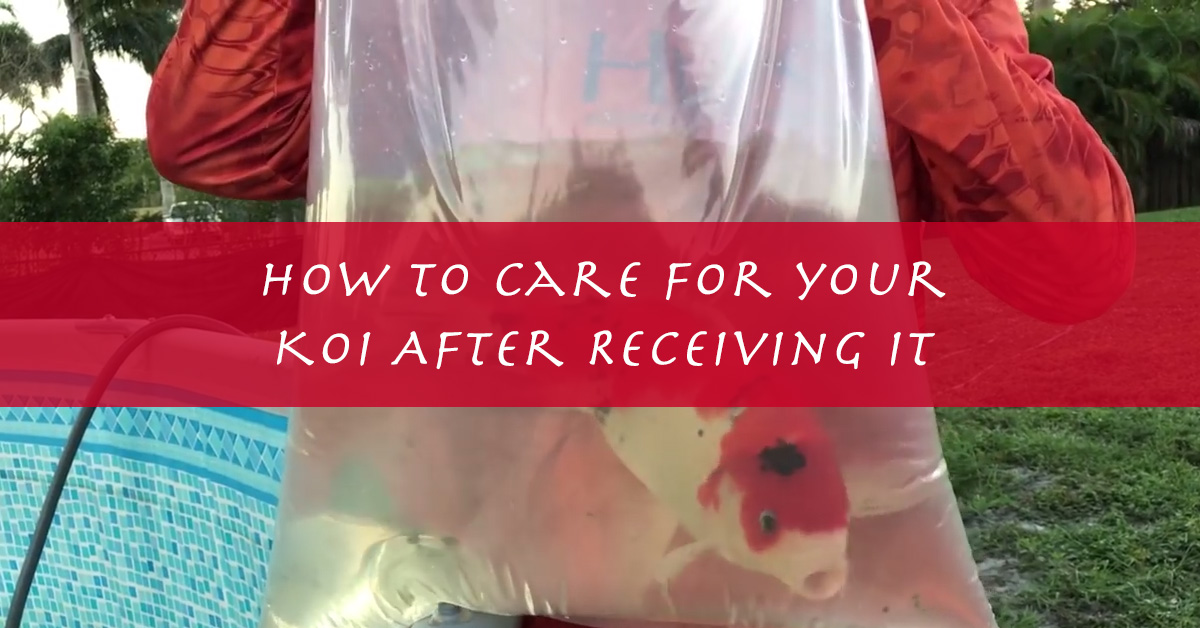
Use this guide to properly introduce new koi fish into your pond using the proper quarantining, pond care, and water quality control methods for good husbandry in koi care. Based on our Japanese breeders and koi farm, these techniques are what work best when receiving Kodama koi but are also good tips for any koi pond owner adding more koi to their pond.
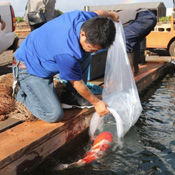 Adding new koi to your pond is exciting and fun but should be approached with caution. If you have not added any outside koi in over a year than take extra precautions mentioned in this article on koi care.
Adding new koi to your pond is exciting and fun but should be approached with caution. If you have not added any outside koi in over a year than take extra precautions mentioned in this article on koi care.
The natural instinct for Nishikigoi is to coexist with others and to bring peace into a home, which is part of their attraction along with their beauty.
In fact, the peace and enjoyment it brings to many koi and pond owners have grown Nishikigoi appreciation into a global culture.
Use these tips to ensure a safe and successful quarantining / addition / koi care routines for new koi.
Table of Contents – Koi Care Tips:
-
- Is it Hard to Take Care of Koi Fish?
- Do I Quarantine New Koi Fish?
- Setup Before Receiving Koi
- What to Do After Receiving Koi
- Factors To Raising & Caring For Nishikigoi
- Koi Pond Environment
- Aquarium Environment
- Introducing Into Your Pond
- Daily Koi Care & Maintenance Tips
- Koi Pond Water Quality Control
- Summer Koi Feeding Tips
- Do Koi Sleep at Night?
- Kodama Koi Farm Best Practices
Is it Hard to Take Care of Koi Fish?
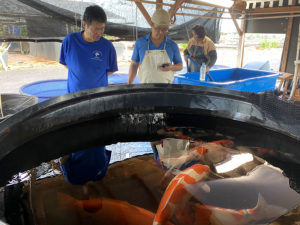 No, koi fish care is not hard, but has specific challenges.
No, koi fish care is not hard, but has specific challenges.
Keeping their water clean, balanced and aerated is the highest priority.
They can survive through winters and are omnivores with plenty of food options. They are peaceful and hardy creatures. Koi create an intimate ecosystem and are susceptible to the pathogens from outsiders. By taking the time to slowly introduce new koi, you allow them to acclimate to each other and ensure the health of everyone!
The natural instinct for Nishikigoi is to coexist with others and to bring peace into a home. This, along with their beauty, is a big part of their attraction.
The peace and enjoyment it brings to koi pond owners has brought Nishikigoi appreciation out of Japan and into global culture. We want you to experience the fun and excitement of growing your koi family, and know a little caution can go a long way, especially if you have not added any outside koi in over a year. Take the extra precautions outlined in this article on koi care and you will have a lifetime of tranquility and joy.
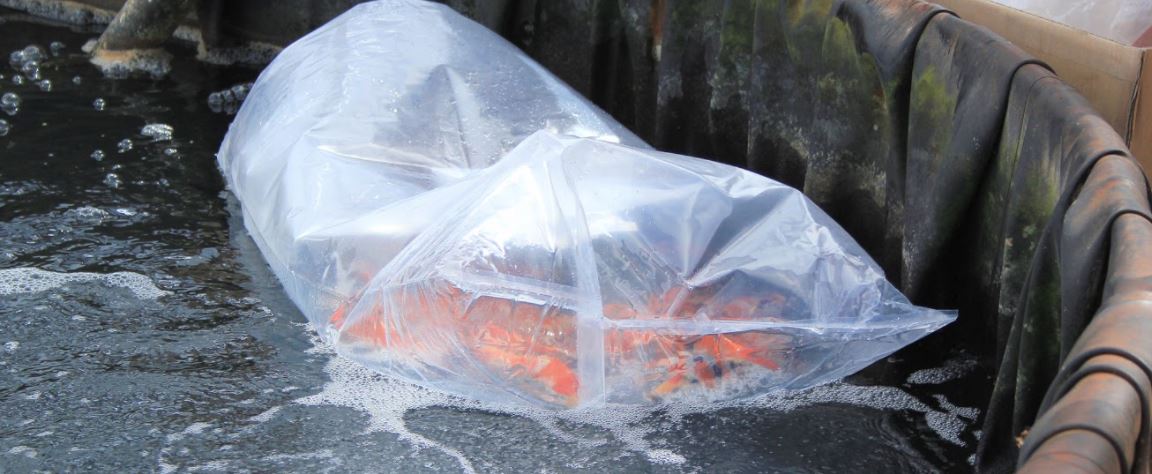
The Importance of Quarantine for New Koi
A necessary tool for all koi hobbyists and owners is a separate quarantine tank. It is strongly recommended that every Kodama Koi purchased should be quarantined before adding to your aquarium or pond. Learn more on our other blog post about koi quarantine tank setup & procedures.
Even with the best care and precautions Nishikigoi carry parasites, bacteria, fungus, and other illnesses. Your koi learn to coexist with local bacteria, but are susceptible to outsiders. Quarantining and introducing local fish and water slowly allows all fish to adapt at a safer pace.
It’s not just about introducing something unhealthy to your current fish population either. Japanese Koi Fish bought online tend to become extremely stressed and exhausted while in transport from the farm or breeder to the owner. A new fish is even more susceptible to sickness, so the quarantine process gives them time to gets their immunity back up to be a healthy new family addition!
Read this other blog to learn more about fish transportation and koi moving tips.
It’s important to provide a comfortable setting for your Nishikigoi to rest and recover from their journey.
How Do I Quarantine My Koi Fish (Nishikigoi)?
It is recommended to keep and treat newly purchased Japanese koi fish in a separate quarantine tank for at least 21 days before introducing them to your pond or aquarium to reduce the risk of disease while giving them time to adjust.
Basic supplies needed for a quarantine tank:
- The tank (100-300 gallons)
- Net cover for the tank
- Small pump and filter
- Air pump
- Water thermometer
- Test kit for ammonia, nitrate, pH, and salt
- Salt
- Pond or aquarium heater
- Ultimate
Setup Before You Receive Nishikigoi
1. Prepare the quarantine tank depending on the size of your koi. We recommend 100-300 gallons, blue show tanks are OK too.
2. Depending on the water of your existing pond, fill the tank with your pond stock (given it’s in good condition), fresh dechlorinated water, or well water.
3. Ideally, the quarantine tank should have a filtration system as well, but sound aeration from an air pump is acceptable.
4. Maintain a water temperature of 72° F or above. If working with a smaller tank, 1-2 aquarium heaters will work to achieve that.
5. Add salt to the tank until it is 0.3% concentration (3 pounds of salt per 100 gallons of water)
What To Do After You Receive Nishikigoi
1. Observe for 14-21 Days – Place your Japanese koi fish into the quarantine tank and observe carefully for 14-21 days. Please watch to see if they develop any problems.
2. Filter or Change Water Every 2-3 Days – If working without a filtration system, partial water changes are needed every 2-3 days of about 25%. Add salt to adjust accordingly.
3. Feed Easily Digestible Food – Feed your Nishikigoi with digestible koi food every day. We recommend Manda Fu Koi Food.
4. Check Nitrate and Ammonia Daily – During this initial period, it is EXTRA important to keep your nitrate levels balanced. A new koi, fresh from the stresses of traveling (shipping), is more susceptible to problems.
Please note – If you have not added any new koi in over a year, it is particularly important to quarantine both new and existing Nishikigoi. It is highly recommended to introduce one of your old Nishikigoi into the quarantine tank after the new koi has gone through normal procedure to ensure that all koi in your pond can coexist in the same water conditions and ecosystem.
We also suggest raising the salt level to 0.5% in this scenario.
View Our Recommended Koi Supplies
For all your quarantine supplies, visit and browse Kodama Koi Supply. We procure only the best koi pond supplies that Japanese breeders use to grow high quality Nishikigoi.
Factors To Raising & Caring For Nishikigoi
There are many factors to raising healthy and happy Japanese koi fish, especially if the goal is for them achieve the prized Grand Champion of a koi show. From the environment of the Nishikigoi to their daily care, there are many things to consider before and after receiving your koi from your favorite Nishikigoi breeder.
Koi Environment
The first step when receiving your Nishikigoi is to create a suitable environment to raise your Japanese koi fish in, whether it be in a pond of aquarium. The tables below highlight the ideal conditions for each environment.
Koi Pond Environment
|
Aquarium Environment
|
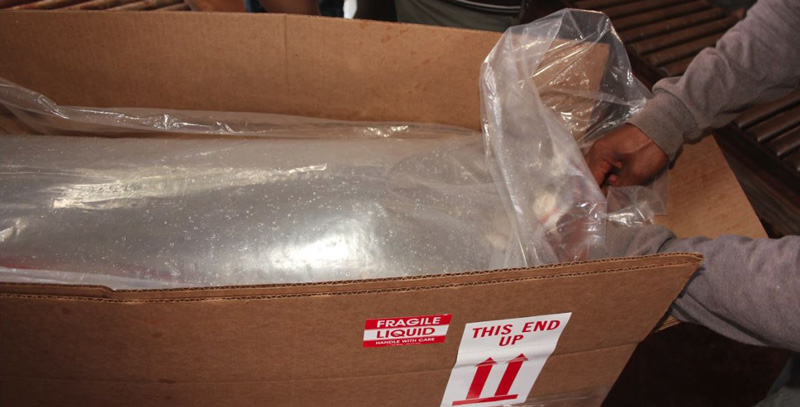
Introducing Nishikigoi Into Your Pond
Now that you’ve received your long-awaited Nishikigoi, it’s time to add these living jewel to your pond or aquarium. But wait! Don’t just place them directly into your pond or aquarium because that can cause major changes to their health.
It is extremely important to be careful when acclimating your Japanese koi fish into your environment so they won’t become stressed. You have pay close attention and heed the steps below when introducing your Nishikigoi into a new environment.
Steps For Introducing Koi In Ponds
1. Don’t open the plastic bag right away. Let the Nishikigoi remain in the bag for approximately 20 minutes before slowly opening the bag.
2. Incorporate some of your pond water into the bag until it becomes half full.
3. Allow the Nishikigoi to adjust to this new water.
4. Finally, gently place the Nishikigoi into the pond.
Steps For Introducing Koi In Aquariums
1. Using a tub, add in water from your aquarium and the plastic bag so it is a half and half (1:1 ratio). Gently remove your Nishikigoi from the bag and add it to the tub.
2. Repeat adding equal parts of plastic bag and aquarium water into the tub until the water temperature in the tub matches your aquarium water temperature.
3. Finally, transport your Nishikigoi from the tub to the aquarium.
Another consideration to keep in mind is how long ago your last Nishikigoi was added to your pond. If it has been more than a year, you need to be extremely careful when adding your new Nishikigoi into the pond since it may cause issues for either your existing or new inhabitants. Each pond has its own ecosystem so the inhabitants tend to build up an immunity to what that ecosystem consists of. Therefore, Nishikigoi with differing immunity levels can not only affect each other but the pond’s natural balance as well.
We strongly advise not to add wild carp into any koi pond ever since they are more sensitive.
Your pond has established an ecosystem based on all the existing inhabitants, especially if it’s been that way for over a year. That is why it is important to be careful when introducing a new koi that has been raised in completely different surroundings since that can affect the balance of your pond’s delicate ecosystem. The new koi may not have enough immunity developed to withstand your pond or might bring in something your existing koi is not immune to.
To prevent this imbalance from occurring, we suggest submitting both your new and old Nishikigoi to the quarantine procedure to ensure that all koi can coexist peacefully and healthily before being added to the pond.
Daily Koi Care & Maintenance Tips
Although Nishikigoi are known to be easy to care for and adaptable, they do require daily ongoing care.
This care routine is also a determining factor of what types of Nishikigoi you should have in your pond. From feeding to water quality and health control, these three important points should be kept in mind when raising Nishikigoi since different types have different needs.
Feeding Your Koi
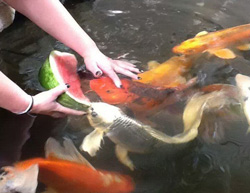 Nishikigoi tend to eat anything that won’t eat them and can consume practically anything that humans do. They are omnivorous by nature and will continuously eat, so excessive feeding can develop health risks for illness just as it will with humans.
Nishikigoi tend to eat anything that won’t eat them and can consume practically anything that humans do. They are omnivorous by nature and will continuously eat, so excessive feeding can develop health risks for illness just as it will with humans.
It is ideal to feed Japanese koi fish an amount that can be eaten within five to ten minutes. It is also recommended to feed them every three to four hours.
In order to best highlight the beauty of Nishikigoi, there are even many types of different koi food created for different situations. From normal koi food to color enhancing to even different water temperatures, there is koi food designed for each need. For instance, any Nishikigoi that has red coloring requires color-enhancing koi food.
Learn more about koi food and how it helps grow healthy living jewels. Read our blog post on the best koi food for color and growth.
Koi Pond Water Quality Control
When breeding Nishikigoi, purification and filtration are essential components in controlling water quality. Filtration will clean the physical matter or objects in the water – such as excrement, leftover food, and leaves. Learn why you need a filter for your koi pond.
Meanwhile purification eliminates invisible matter in the water or waste that is dissolved by bacteria to produce clear refreshing water for the Nishikigoi. Read about the importance of koi clay in your pond.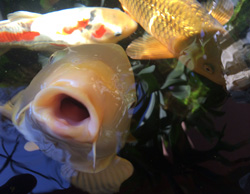
A common solution for the filtration and purification functions needed for ideal water quality is to install lauder tubs. Kodama Koi Farm also recommends the Bio Clean Pond Filter to control the water quality and create a pleasant environment for Nishikigoi.
Another aspect of water quality that needs to be maintained is sufficient oxygen for Nishikigoi. The amount of dissolved oxygen in the water needs to be controlled by an air pump. This is crucial since lack of oxygen can be fatal for Nishikigoi.
Take note if they start gathering around the water filter or sticking their noses out of the water because that means the oxygen levels in the water need to be checked right away.
Koi Fish Health Control
The health of Nishikigoi require daily monitoring.
Koi will show you how they are feeling. It is observed that a group of healthy koi swims freely all over the pond or aquarium. They will spread out and rush over when it is feeding time. They also enjoy the sound of water being aerated as that stimulates their appetite so it is beneficial to have waterfalls in koi ponds.
Keep note of any Nishikigoi that gather in one place or barely move around as that is a sign of disease. Also if Nishikigoi are gathering at the water filter or opening and closing their mouths at the water surface, that signals a lack of dissolved oxygen in the water which is harmful for their health. Read this article on koi sickness and disease management.
In contrast; Nishikigoi that swim at an unusually fast pace, exhibit wobbly movements, or linger motionlessly at the water surface can also be signs of illness. If your Nishikigoi displays any of these sickly conditions, please feel free to contact Kodama Koi Farm for assistance.
Summer Koi Feeding Tips
It is a good time to make a difference for your koi. Depending on how much you feed, you can make a big difference in the condition of their health. If their health is good, your koi can be well prepared for the winter hibernation, and it decreases the chance of an accident when spring comes. If you are feeding poor quality food, or doing something wrong in the summer, your koi could go into hibernation with an unhealthy condition. They might get sick when spring comes due to a bad immune system. That is why it is important to feed your koi quality koi food, even though the cost is higher. Learning what to feed and how to feed your koi is important.
There is a food by the name “Hi-Silk”. How can we use this?
There are 3 different types of food such as all season (year-around), color enhancing, and one that helps with growth. Basically, it is fine to feed only color-up and wheat germ food. But for a level 2 hobbyists who want to raise their koi to be big, they can add Hi-Silk.
Try Hi-Silk Koi food – it is the best food that we have in the koi industry for the koi growth.
How much of Hi-Silk do we add to our koi food?
You can start with a 3:3:3 mixture. If you want your koi to grow even bigger, you can feed your koi a mixture of 5:5 of Hi-Silk and color-up. If you want just a good balance for your koi, try 3:3:3 of All SEASON, color-up and Hi-Silk. If you want more growth, try 5:5 of color-up and Hi-Silk.
Hi-Silk needs to be fed after the water temperature reaches over 65 degrees. You can also increase the amount of Hi-Silk to 7 or 8 (and color-up to 2 or 3) if you want your koi to grow extremely big.
Does Hi-Silk really make your koi grow big?
It sure does! The top breeders in Japan will say that it is silkworms that grows koi big and finishes them beautifully. All koi food manufacturing technicians will agree that silkworms are the ultimate ingredient used in making koi food.
Why are silkworms beneficial? The composition of protein in silkworms (amino acid) is the closest to the protein composition of koi. Koi are naturally able to absorb the protein of silkworms. Fine quailty silkworms are the best natural food for koi.
Another important ingredient used in Hi-Silk 21 is silk powder. Silk is made of a protein called fibroin. This protein contains a number of amino acids that are essential for living creatures such as alanine, glycine and tyrosine. The glycine levels alone make the fibroin level in Hi Silk 21 8 times higher than milk and as much as 6 times higher than eggs.
These amino acids strengthen the liver function of koi, improve detoxification and decrease the cholesterol in the blood. When liver function deteriorates, the skin of the koi will appear yellow. Strengthening liver function will maintain and improve the beautiful crisp whiteness of your koi’s skin.
Do Koi Sleep at Night?
We often see dogs and cats fall asleep with their eyes closed in broad daylight. Sometimes we see them sleeping on beds with our kids. Dogs and cats sleep like humans.
How about koi? Do you think koi sleep?
The islands of Hawaii are surrounded by the ocean, people here would go fishing in the sea. In Japan, however, people would go either to the sea, a river or a swamp. I used to live in Toyota-city where there are no oceans nearby, so I had to go to the Yahagi River to fish. In the hot summer, we went night fishing. If you have ever experienced night fishing, you might have noticed that there is a period of time such as 1:00 a.m. to 3:00 a.m. when you couldn’t catch any fish at all. We usually used this time period for chatting and talking about fishing. I assume this is the time when fish sleep.
Koi kept in the garden ponds stay still on the bottom when it gets dark at night. This could be the way they sleep. Koi can also hibernate. When the water temperature becomes below 46.4°F in winter, they will pick a dark area to stay put together. It is like they are sleeping together.
There is also narcolepsy for koi. This symptom is caused by a lack of minerals in their diet. This is common for baby fish, 4 to 6 inches in length. If the koi at the koi farms have narcolepsy, they all lay down sideways and it looks just like they are all sleeping. Therefore, the answer to the question, “Do koi sleep?”—is yes. When they stop being active and stay still, they are sleeping.
Kodama Koi Farm Best Practices
Here at Kodama Koi Farm, we work tirelessly to ensure that all Nishikigoi sold are at their best health and highest quality. Using our best efforts, Kodama Koi go through an intensive 3-week quarantine before any auction and being shipped so they are ready to be tested by the State Agricultural Board.
“As a Japanese Koi dealer, I felt it is my responsibility to provide the appropriate approach and knowledge to beauty of Japanese Koi.” – Mamoru Kodama
Kodama Koi are properly treated with the best medications according to each individual koi’s needs. Nishikigoi skin samples are also retrieved with caring hands and examined under a microscope for any potential health conditions. Whenever Nishikigoi is imported directly from breeders, Mamoru Kodama closely examines each Nishikigoi before purchase.
Kodama Koi Farm quarantine procedures:
- Every shipment of new Nishikigoi are quarantine in an isolated greenhouse on the farm in Hawaii with restricted access for a minimum of 3 weeks.
- The pond is heated to at least 72° F to purposefully draw out any bacteria, parasites, fungus, or virus to be treated in the quarantine surroundings rather than a main pond.
- During the quarantine process, the new shipment of Nishikigoi is also kept with KHV free koi which catches any problems like the canaries did in old coal mines.
- After quarantining for 3 weeks, the new Nishikigoi are sent to a laboratory to see if they have any hidden or invisible diseases regardless of if they became sick or not while in quarantine. No Nishikigoi or any from their shipment will be sold until a clean bill of health is confirmed from the laboratory.
- Every piece of equipment used, like tubs and nets, are disinfected after each use. No Nishikigoi returns are accepted since Kodama Koi Farm is not responsible for the customer’s pond or the koi’s condition once it leaves our facility.
- Although Kodama Koi Farm is open to the public on the weekends, nobody but our staff members are allowed to touch the koi, nets, or water. Kodama Koi Farm staff members are trained to bleach our hands and arms whenever working or handling water in different ponds.
Kodama Koi imported from Miyoshiike receive an extra 3 weeks of quarantine with careful health management. Several Nishikigoi are randomly selected from each breeder and tested at 72° F to see if any illnesses come out. Since it is a long and stressful journey from Japan to the US, it is critical that only healthy koi are shipped. This combined with the quarantine that Kodama Koi Farm conducts in the US ensures that the koi are fully healthy.
We hope this koi care guide has been helpful and prepared you for your new shipment of Kodama Koi. If you are looking for local pond care and quarantine supplies, please look into our Kodama Koi Garden stores.
Are you looking to add to your koi pond family? Browse all live koi available from Kodama
View our FAQs for more details.
Recommended reading on Kodama Koi Garden:
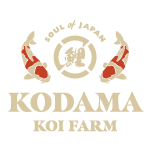
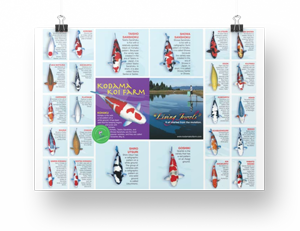

Great info!! I am impressed by your blog; here I gain the information about how to care your koi fish. It’s beneficial and helpful information for us. Thanks for this kind of information.
Thank you
I’m gonna buy from you soon!
I love all the detailed info !
What’s the approximate wait time for a delivery to California
Thank you.
Once you confirm the purchase, we need 3-7 days to prepare for the shipment.
Then, we will send it to you overnight.
thank you so much for the overview of everything. Question? I lost all of my fish about 25 this last Oct-Nov. The pond is now cold but not frozen with 3 aeration and one pond red ring for ventilation. The fish did not die from disease. Something or someone came and took them about 4-5 at a time over 3 weeks. How should I prepare the water for new fish this spring-summer? Thinking of installing a large heater to help warm the temperature up for them. I want the new fish to have a healthy start. Any suggestions are greatly appreciated.
Hello, I am very sorry for what happened. It is terrible someone came and stole the pets.
If I were you, I would basically change all the water. Drain everything and refill with fresh water. I will add dechrolinator and run the pupmp/filter for a few days. Maybe you can add a few small test Koi to make sure. If you are not certain about the quality of water in the pond now, I think this is the easiest and safest way
I have a man made pond 25x15x5. It is not filtered, but aerated via a series of waterfalls from smaller ponds above. I live in Michigan but because the pond is kept moving it doesn’t freeze over. My questions are, is this an adequate habitat for koi and how many could I keep and maintain their health? Another issue is that I have geese that frequently visit the pond system. Thank you for in advance for your reply.
Hi Mr. Ayers, Thank you very much for your question. It is very hard to answer your questions without seeing your pond. If the pond is closed system, in other words, if fresh water does not keep coming in and out, you should be very careful with water quality. I recommend you check water quality often and do regular water change because you do not have a filter system that can develop nitrogen cycle. The filteration capacity really determines how many you can keep in the pond.
Como me gustaria visitar esa Granja y / o poder comprar unos cuantos ejemplares.
Pero aca en chile es muy dificil no se se podra.
Otra condulta, cuantos serian los tds que debe tener un estanque de unos 20 mil litros, cuales son los tds que estos peces tienen en nigata.
Saludos desde Melipilla Provincia de Santiago de Chile.
As I would like to visit that Farm and / or be able to buy a few copies.
But right up in chile it’s very hard not to be able to.
Another sweet, how many would be the tds that must have a pond of about 20 thousand liters, which are the tds that these fish have in nigata.
Greetings from Melipilla Province of Santiago de Chile.
Thank you for your comments from Chile. One day, we would like to ship Koi to your country.
After finish quarantine the fish, can I put the fish directly into the pond?
Hi
After quarantine and no issues then yes.
What exactly are we to look for during the quarantine period?
The quarantine period is to help destress you koi from the motions of traveling. Day after day you should notice your koi starting to get back to normal. Look for any issues that may appear to be preventing the koi from acting in a normal state. At any time during your quarantine period you notice something questionable feel free to contact customer support to get advice from an expert.
I have a relatively new man made pond with complete aeration and black light filtration. I have added three rescue koi wh seem to be doing well. My pond base (rock) is mossy green. Is that harmful to my fish ?
Hello – what salt do you recommend to add once we receive our koi? Also, do you recommend salt in the pond as well for everyday health? Thank you.